Palestinian vs Arab Community Comparison
COMPARE
Palestinian
Arab
Social Comparison
Social Comparison
Palestinians
Arabs
9,319
SOCIAL INDEX
90.7/ 100
SOCIAL RATING
20th/ 347
SOCIAL RANK
6,013
SOCIAL INDEX
57.6/ 100
SOCIAL RATING
166th/ 347
SOCIAL RANK
Arab Integration in Palestinian Communities
The statistical analysis conducted on geographies consisting of 216,468,757 people shows a strong positive correlation between the proportion of Arabs within Palestinian communities in the United States with a correlation coefficient (R) of 0.786. On average, for every 1% (one percent) increase in Palestinians within a typical geography, there is an increase of 0.865% in Arabs. To illustrate, in a geography comprising of 100,000 individuals, a rise of 1,000 Palestinians corresponds to an increase of 865.3 Arabs.
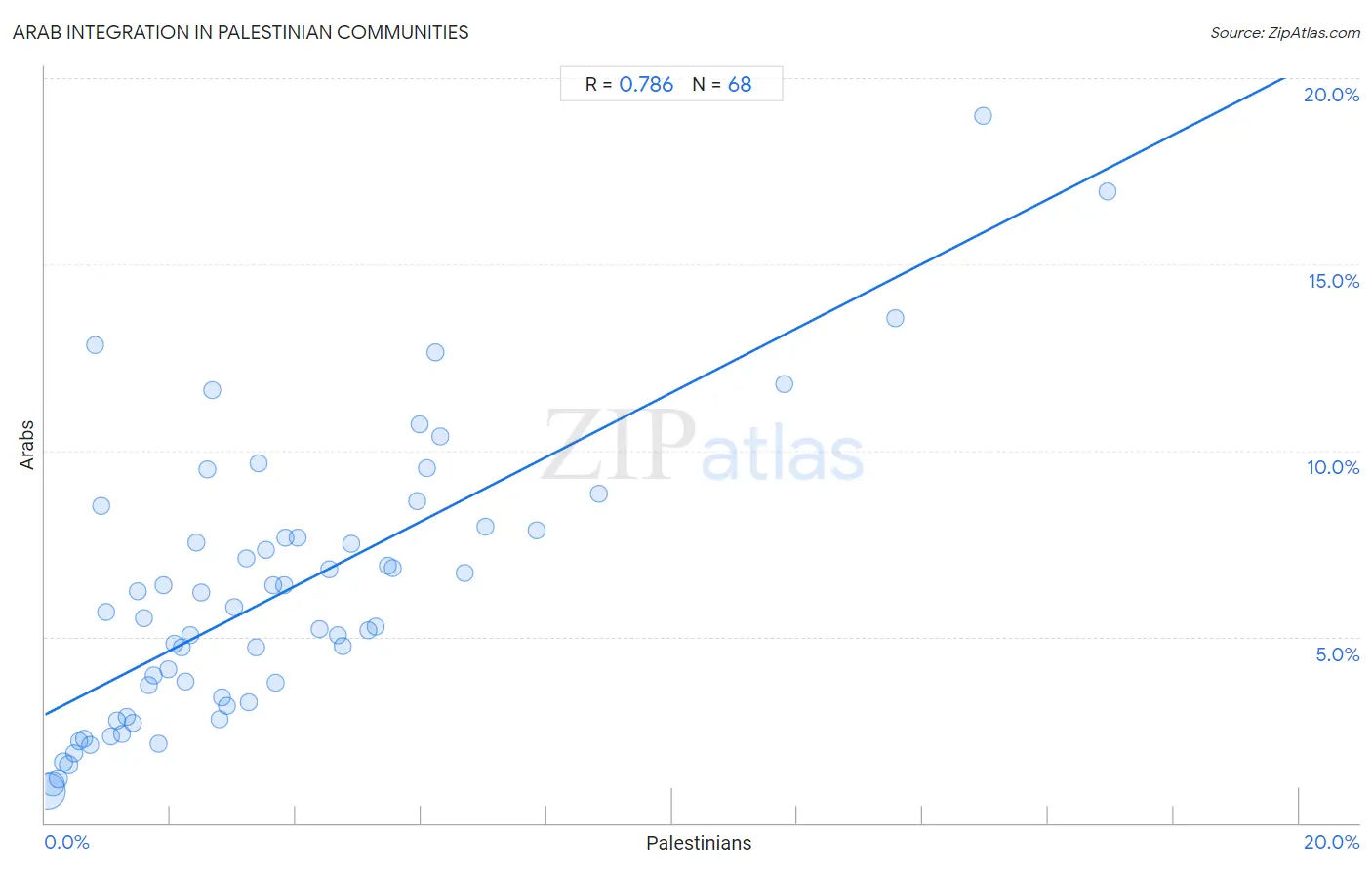
Palestinian vs Arab Income
When considering income, the most significant differences between Palestinian and Arab communities in the United States are seen in householder income ages 45 - 64 years ($107,721 compared to $104,566, a difference of 3.0%), median household income ($90,574 compared to $88,398, a difference of 2.5%), and householder income over 65 years ($63,800 compared to $62,266, a difference of 2.5%). Conversely, both communities are more comparable in terms of per capita income ($45,790 compared to $45,662, a difference of 0.28%), householder income under 25 years ($51,515 compared to $51,219, a difference of 0.58%), and median male earnings ($57,778 compared to $57,298, a difference of 0.84%).

| Income Metric | Palestinian | Arab |
| Per Capita Income | Exceptional $45,790 | Exceptional $45,662 |
| Median Family Income | Exceptional $109,413 | Excellent $106,952 |
| Median Household Income | Exceptional $90,574 | Excellent $88,398 |
| Median Earnings | Exceptional $49,209 | Exceptional $48,599 |
| Median Male Earnings | Exceptional $57,778 | Exceptional $57,298 |
| Median Female Earnings | Exceptional $41,484 | Excellent $40,718 |
| Householder Age | Under 25 years | Poor $51,515 | Tragic $51,219 |
| Householder Age | 25 - 44 years | Exceptional $98,777 | Excellent $97,336 |
| Householder Age | 45 - 64 years | Exceptional $107,721 | Excellent $104,566 |
| Householder Age | Over 65 years | Exceptional $63,800 | Good $62,266 |
| Wage/Income Gap | Fair 26.1% | Poor 26.6% |
Palestinian vs Arab Poverty
When considering poverty, the most significant differences between Palestinian and Arab communities in the United States are seen in married-couple family poverty (4.9% compared to 5.7%, a difference of 16.2%), receiving food stamps (10.3% compared to 11.5%, a difference of 11.3%), and family poverty (8.3% compared to 9.2%, a difference of 11.0%). Conversely, both communities are more comparable in terms of single male poverty (12.7% compared to 13.0%, a difference of 2.0%), single father poverty (15.9% compared to 16.6%, a difference of 4.8%), and female poverty among 25-34 year olds (12.6% compared to 13.2%, a difference of 5.4%).
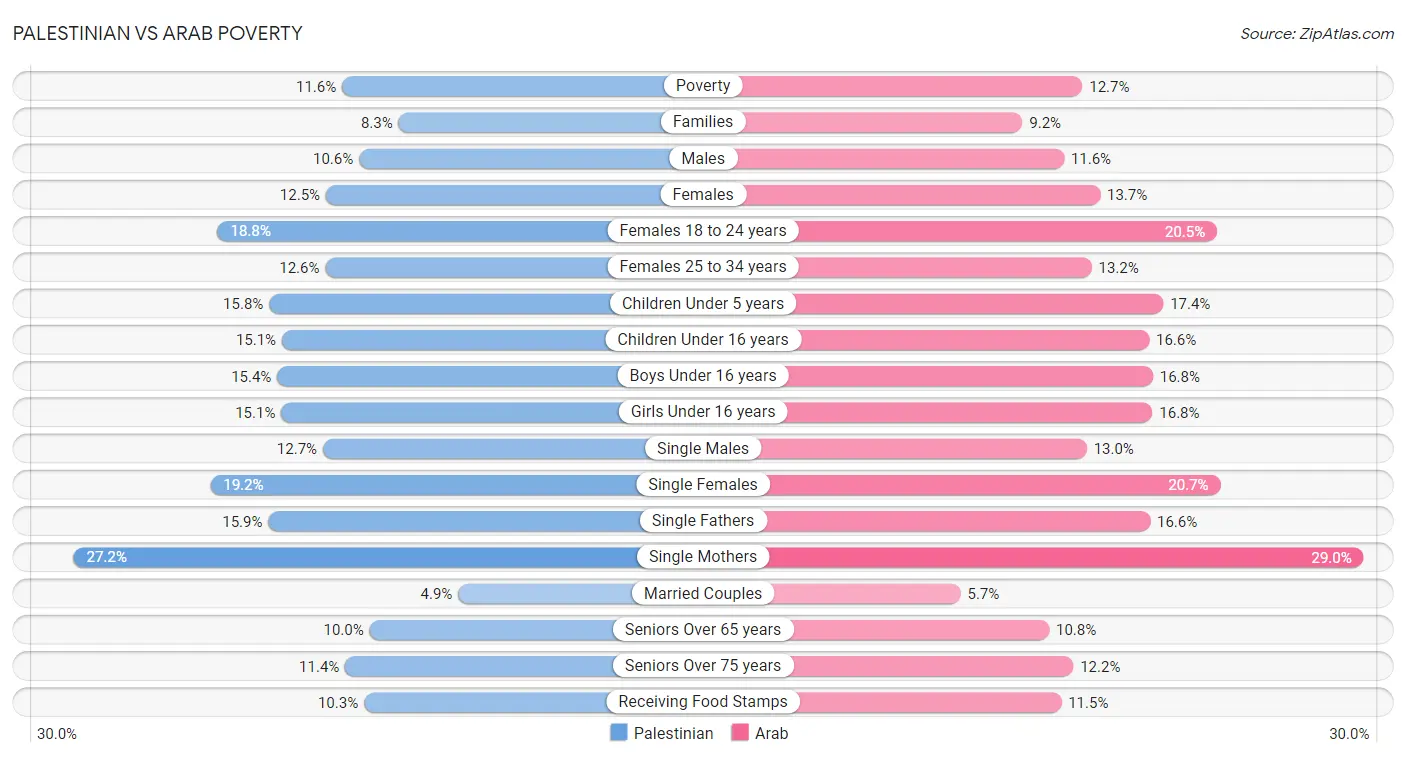
| Poverty Metric | Palestinian | Arab |
| Poverty | Exceptional 11.6% | Fair 12.7% |
| Families | Exceptional 8.3% | Fair 9.2% |
| Males | Excellent 10.6% | Poor 11.6% |
| Females | Exceptional 12.5% | Fair 13.7% |
| Females 18 to 24 years | Exceptional 18.8% | Poor 20.5% |
| Females 25 to 34 years | Exceptional 12.6% | Good 13.2% |
| Children Under 5 years | Exceptional 15.8% | Average 17.4% |
| Children Under 16 years | Exceptional 15.1% | Fair 16.6% |
| Boys Under 16 years | Exceptional 15.4% | Fair 16.8% |
| Girls Under 16 years | Exceptional 15.1% | Fair 16.8% |
| Single Males | Good 12.7% | Fair 13.0% |
| Single Females | Exceptional 19.2% | Good 20.7% |
| Single Fathers | Exceptional 15.9% | Poor 16.6% |
| Single Mothers | Exceptional 27.2% | Good 29.0% |
| Married Couples | Exceptional 4.9% | Tragic 5.7% |
| Seniors Over 65 years | Exceptional 10.0% | Good 10.8% |
| Seniors Over 75 years | Exceptional 11.4% | Average 12.2% |
| Receiving Food Stamps | Exceptional 10.3% | Good 11.5% |
Palestinian vs Arab Unemployment
When considering unemployment, the most significant differences between Palestinian and Arab communities in the United States are seen in unemployment among women with children under 6 years (7.2% compared to 7.9%, a difference of 10.0%), unemployment among ages 55 to 59 years (4.5% compared to 4.8%, a difference of 8.4%), and unemployment among ages 35 to 44 years (4.3% compared to 4.7%, a difference of 8.3%). Conversely, both communities are more comparable in terms of unemployment among ages 20 to 24 years (10.6% compared to 10.6%, a difference of 0.13%), unemployment among youth under 25 years (11.8% compared to 11.8%, a difference of 0.15%), and unemployment among ages 60 to 64 years (4.8% compared to 4.8%, a difference of 0.79%).
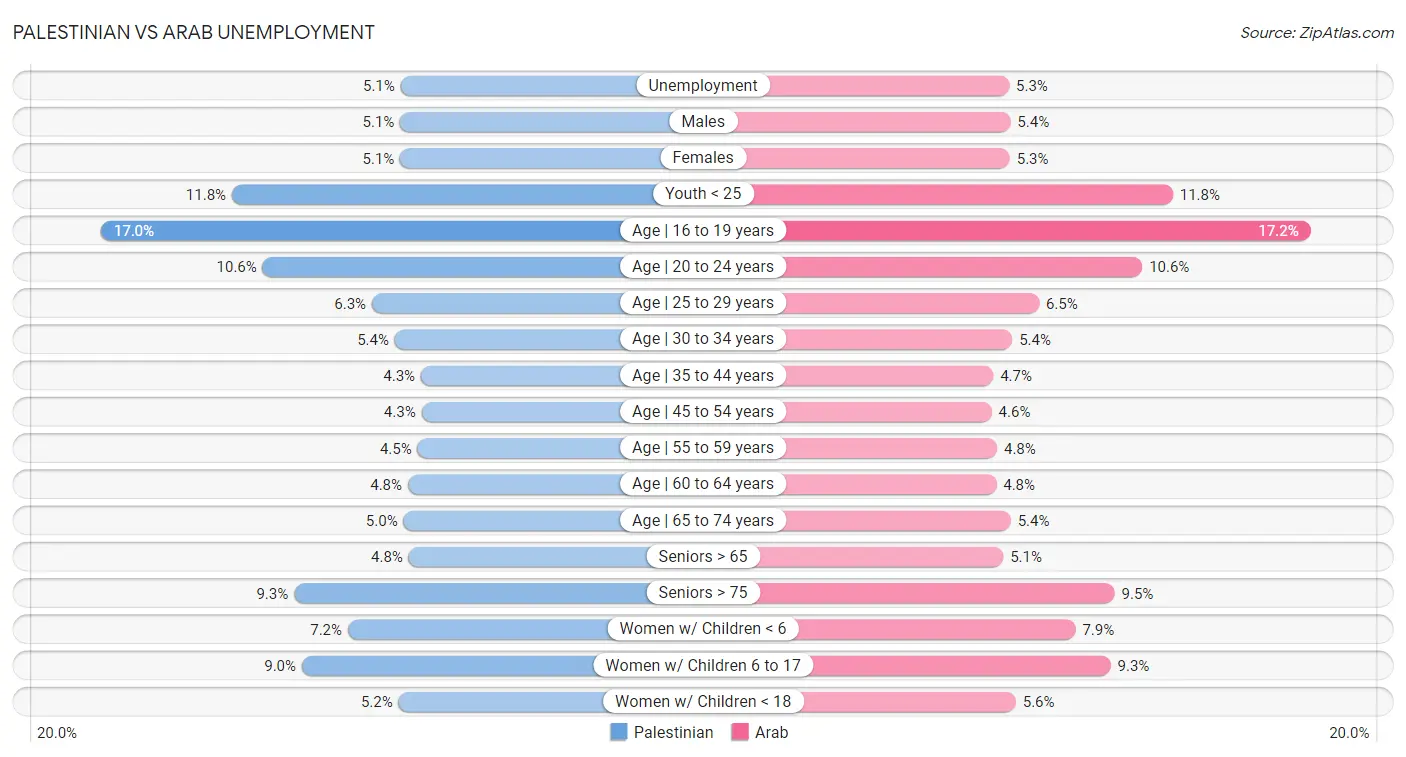
| Unemployment Metric | Palestinian | Arab |
| Unemployment | Excellent 5.1% | Fair 5.3% |
| Males | Excellent 5.1% | Fair 5.4% |
| Females | Excellent 5.1% | Fair 5.3% |
| Youth < 25 | Poor 11.8% | Poor 11.8% |
| Age | 16 to 19 years | Exceptional 17.0% | Excellent 17.2% |
| Age | 20 to 24 years | Tragic 10.6% | Tragic 10.6% |
| Age | 25 to 29 years | Exceptional 6.3% | Excellent 6.5% |
| Age | 30 to 34 years | Good 5.4% | Average 5.4% |
| Age | 35 to 44 years | Exceptional 4.3% | Average 4.7% |
| Age | 45 to 54 years | Exceptional 4.3% | Poor 4.6% |
| Age | 55 to 59 years | Exceptional 4.5% | Average 4.8% |
| Age | 60 to 64 years | Good 4.8% | Good 4.8% |
| Age | 65 to 74 years | Exceptional 5.0% | Average 5.4% |
| Seniors > 65 | Exceptional 4.8% | Excellent 5.1% |
| Seniors > 75 | Tragic 9.3% | Tragic 9.5% |
| Women w/ Children < 6 | Exceptional 7.2% | Tragic 7.9% |
| Women w/ Children 6 to 17 | Fair 9.0% | Tragic 9.3% |
| Women w/ Children < 18 | Exceptional 5.2% | Fair 5.6% |
Palestinian vs Arab Labor Participation
When considering labor participation, the most significant differences between Palestinian and Arab communities in the United States are seen in in labor force | age 20-24 (75.6% compared to 74.6%, a difference of 1.4%), in labor force | age 45-54 (83.3% compared to 82.4%, a difference of 1.1%), and in labor force | age 35-44 (84.7% compared to 83.8%, a difference of 1.1%). Conversely, both communities are more comparable in terms of in labor force | age 16-19 (36.8% compared to 36.8%, a difference of 0.030%), in labor force | age 25-29 (84.7% compared to 84.2%, a difference of 0.48%), and in labor force | age 30-34 (84.9% compared to 84.3%, a difference of 0.63%).

| Labor Participation Metric | Palestinian | Arab |
| In Labor Force | Age > 16 | Exceptional 65.9% | Good 65.2% |
| In Labor Force | Age 20-64 | Exceptional 80.0% | Poor 79.2% |
| In Labor Force | Age 16-19 | Good 36.8% | Good 36.8% |
| In Labor Force | Age 20-24 | Excellent 75.6% | Poor 74.6% |
| In Labor Force | Age 25-29 | Average 84.7% | Tragic 84.2% |
| In Labor Force | Age 30-34 | Good 84.9% | Tragic 84.3% |
| In Labor Force | Age 35-44 | Excellent 84.7% | Tragic 83.8% |
| In Labor Force | Age 45-54 | Exceptional 83.3% | Poor 82.4% |
Palestinian vs Arab Family Structure
When considering family structure, the most significant differences between Palestinian and Arab communities in the United States are seen in births to unmarried women (28.4% compared to 29.2%, a difference of 2.7%), single mother households (5.9% compared to 6.0%, a difference of 2.4%), and married-couple households (48.0% compared to 46.9%, a difference of 2.1%). Conversely, both communities are more comparable in terms of average family size (3.23 compared to 3.23, a difference of 0.13%), family households with children (28.1% compared to 28.0%, a difference of 0.38%), and single father households (2.2% compared to 2.1%, a difference of 1.0%).

| Family Structure Metric | Palestinian | Arab |
| Family Households | Exceptional 65.1% | Fair 64.1% |
| Family Households with Children | Exceptional 28.1% | Exceptional 28.0% |
| Married-couple Households | Exceptional 48.0% | Good 46.9% |
| Average Family Size | Average 3.23 | Average 3.23 |
| Single Father Households | Exceptional 2.2% | Exceptional 2.1% |
| Single Mother Households | Exceptional 5.9% | Excellent 6.0% |
| Currently Married | Exceptional 47.6% | Good 47.0% |
| Divorced or Separated | Exceptional 11.5% | Exceptional 11.6% |
| Births to Unmarried Women | Exceptional 28.4% | Exceptional 29.2% |
Palestinian vs Arab Vehicle Availability
When considering vehicle availability, the most significant differences between Palestinian and Arab communities in the United States are seen in no vehicles in household (8.3% compared to 10.5%, a difference of 25.7%), 4 or more vehicles in household (6.4% compared to 6.0%, a difference of 6.5%), and 3 or more vehicles in household (20.1% compared to 18.9%, a difference of 6.2%). Conversely, both communities are more comparable in terms of 1 or more vehicles in household (91.7% compared to 89.6%, a difference of 2.4%), 2 or more vehicles in household (57.7% compared to 55.0%, a difference of 4.9%), and 3 or more vehicles in household (20.1% compared to 18.9%, a difference of 6.2%).

| Vehicle Availability Metric | Palestinian | Arab |
| No Vehicles Available | Exceptional 8.3% | Average 10.5% |
| 1+ Vehicles Available | Exceptional 91.7% | Average 89.6% |
| 2+ Vehicles Available | Exceptional 57.7% | Fair 55.0% |
| 3+ Vehicles Available | Excellent 20.1% | Poor 18.9% |
| 4+ Vehicles Available | Good 6.4% | Poor 6.0% |
Palestinian vs Arab Education Level
When considering education level, the most significant differences between Palestinian and Arab communities in the United States are seen in no schooling completed (1.9% compared to 2.1%, a difference of 9.3%), professional degree (4.8% compared to 5.0%, a difference of 5.4%), and doctorate degree (2.0% compared to 2.1%, a difference of 4.5%). Conversely, both communities are more comparable in terms of associate's degree (49.0% compared to 49.0%, a difference of 0.0%), nursery school (98.1% compared to 97.9%, a difference of 0.17%), and kindergarten (98.1% compared to 97.9%, a difference of 0.17%).
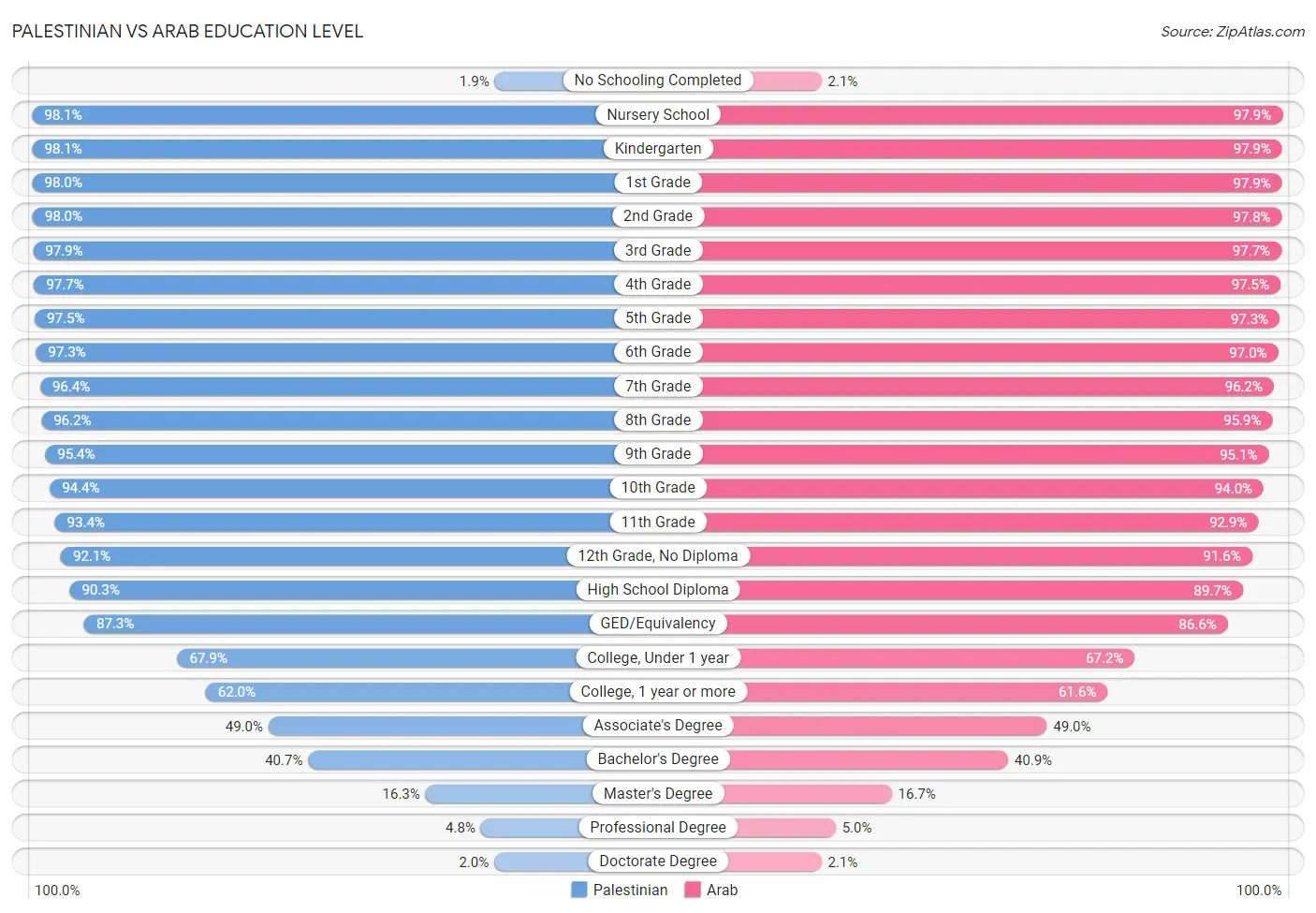
| Education Level Metric | Palestinian | Arab |
| No Schooling Completed | Exceptional 1.9% | Average 2.1% |
| Nursery School | Excellent 98.1% | Fair 97.9% |
| Kindergarten | Excellent 98.1% | Fair 97.9% |
| 1st Grade | Excellent 98.0% | Fair 97.9% |
| 2nd Grade | Excellent 98.0% | Fair 97.8% |
| 3rd Grade | Excellent 97.9% | Fair 97.7% |
| 4th Grade | Excellent 97.7% | Average 97.5% |
| 5th Grade | Excellent 97.5% | Average 97.3% |
| 6th Grade | Exceptional 97.3% | Average 97.0% |
| 7th Grade | Exceptional 96.4% | Good 96.2% |
| 8th Grade | Exceptional 96.2% | Good 95.9% |
| 9th Grade | Exceptional 95.4% | Good 95.1% |
| 10th Grade | Exceptional 94.4% | Excellent 94.0% |
| 11th Grade | Exceptional 93.4% | Excellent 92.9% |
| 12th Grade, No Diploma | Exceptional 92.1% | Excellent 91.6% |
| High School Diploma | Exceptional 90.3% | Excellent 89.7% |
| GED/Equivalency | Exceptional 87.3% | Excellent 86.6% |
| College, Under 1 year | Exceptional 67.9% | Exceptional 67.2% |
| College, 1 year or more | Exceptional 62.0% | Exceptional 61.6% |
| Associate's Degree | Exceptional 49.0% | Exceptional 49.0% |
| Bachelor's Degree | Exceptional 40.7% | Exceptional 40.9% |
| Master's Degree | Exceptional 16.3% | Exceptional 16.7% |
| Professional Degree | Exceptional 4.8% | Exceptional 5.0% |
| Doctorate Degree | Exceptional 2.0% | Exceptional 2.1% |
Palestinian vs Arab Disability
When considering disability, the most significant differences between Palestinian and Arab communities in the United States are seen in disability age 35 to 64 (10.4% compared to 10.9%, a difference of 5.4%), self-care disability (2.3% compared to 2.4%, a difference of 5.1%), and disability age 5 to 17 (5.2% compared to 5.4%, a difference of 4.7%). Conversely, both communities are more comparable in terms of disability age over 75 (46.3% compared to 47.1%, a difference of 1.6%), hearing disability (2.9% compared to 3.0%, a difference of 1.7%), and disability age 18 to 34 (6.4% compared to 6.5%, a difference of 1.9%).
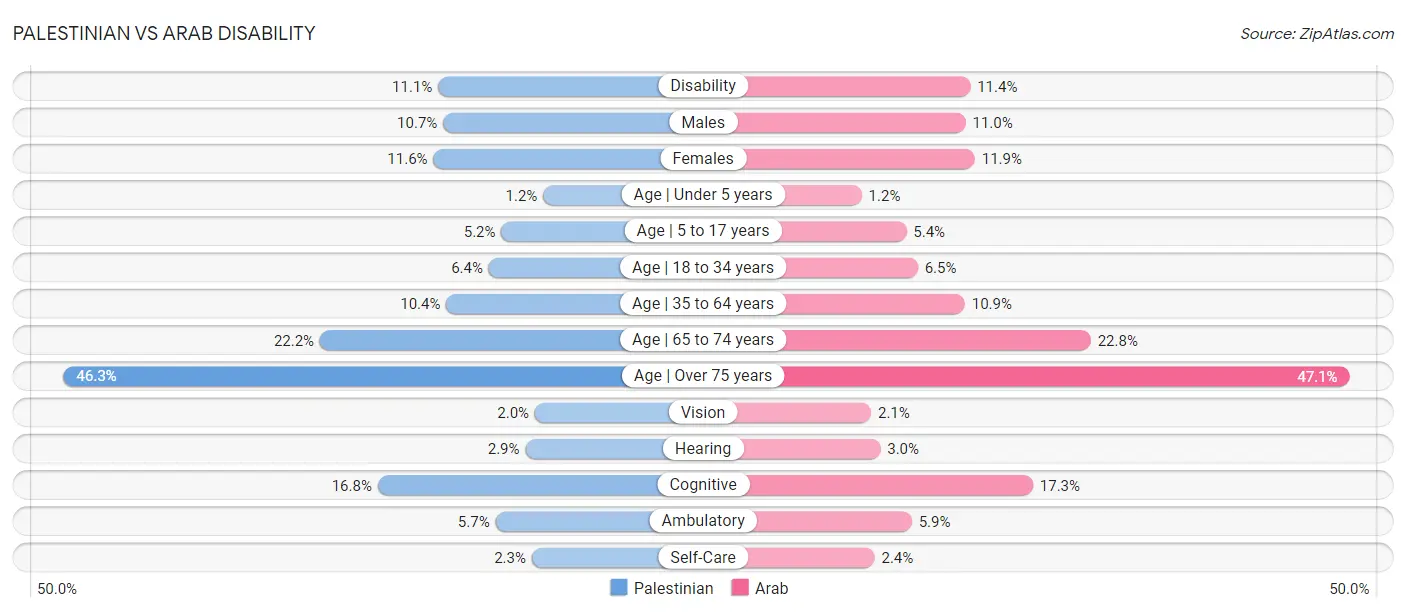
| Disability Metric | Palestinian | Arab |
| Disability | Exceptional 11.1% | Excellent 11.4% |
| Males | Exceptional 10.7% | Excellent 11.0% |
| Females | Exceptional 11.6% | Exceptional 11.9% |
| Age | Under 5 years | Average 1.2% | Good 1.2% |
| Age | 5 to 17 years | Exceptional 5.2% | Exceptional 5.4% |
| Age | 18 to 34 years | Excellent 6.4% | Good 6.5% |
| Age | 35 to 64 years | Exceptional 10.4% | Excellent 10.9% |
| Age | 65 to 74 years | Exceptional 22.2% | Excellent 22.8% |
| Age | Over 75 years | Exceptional 46.3% | Good 47.1% |
| Vision | Exceptional 2.0% | Excellent 2.1% |
| Hearing | Good 2.9% | Average 3.0% |
| Cognitive | Exceptional 16.8% | Average 17.3% |
| Ambulatory | Exceptional 5.7% | Exceptional 5.9% |
| Self-Care | Exceptional 2.3% | Good 2.4% |